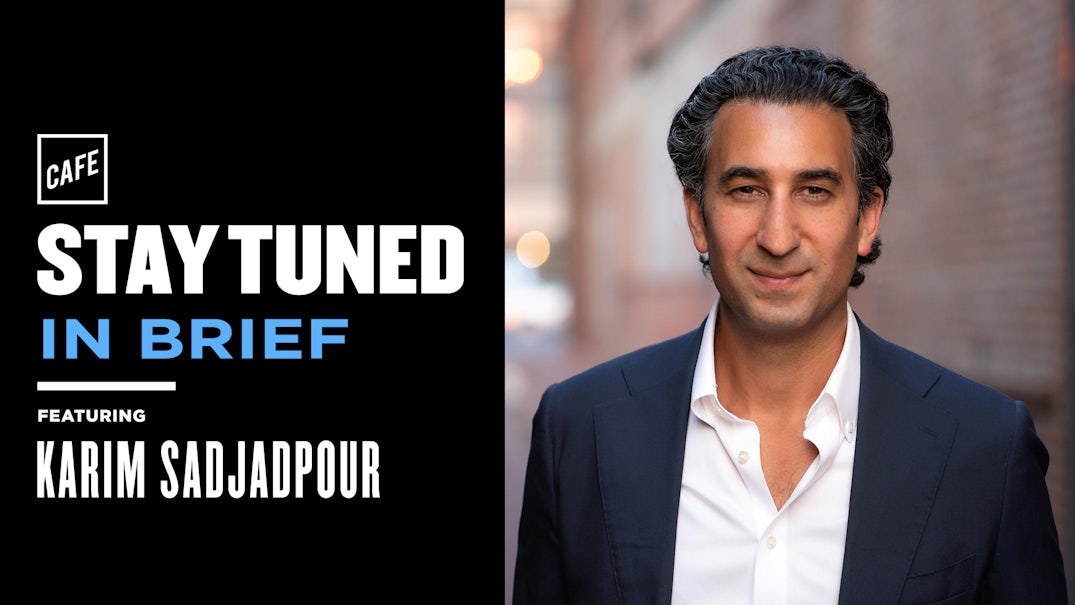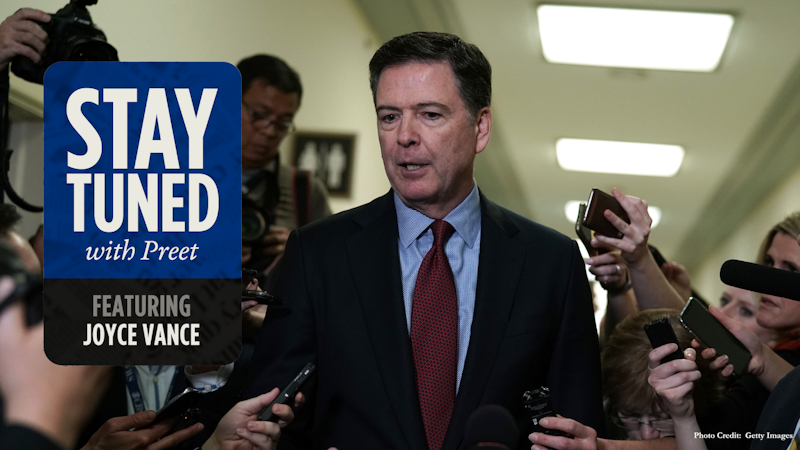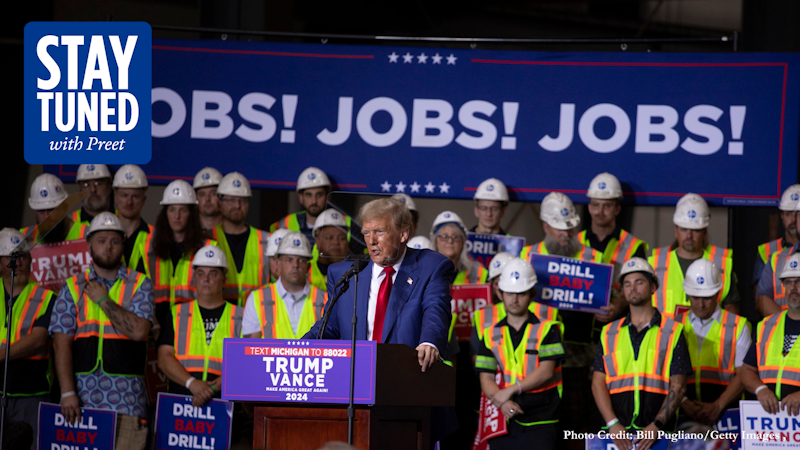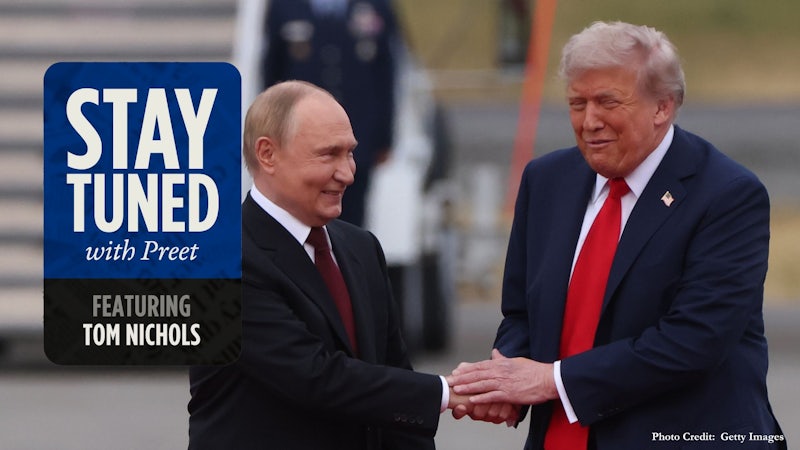Preet Bharara:
From Cafe and the Vox Media Podcast Network, welcome to Stay Tuned in Brief. I’m your host Preet Bharara. This week we’re going to talk about Iran. Many of us have seen videos on social media of the protests that erupted over three weeks ago when a 22-year-old woman named Mahsa Amini died in police custody. She had been arrested for allegedly violating laws requiring women to wear headscarves. The protests are reportedly the largest to sweep the country since 2009, and many are speculating about what they mean for the future of the autocratic regime. My guest this week is Karim Sadjadpour, one of the foremost foreign policy experts on Iran. He’s a senior fellow with the Carnegie Endowment for International Peace. Karim, welcome to the show.
Karim Sadjadpour:
Thank you so much Preet.
Preet Bharara:
So let’s start at the beginning for people who may not be following this very important story. Who was Mahsa Amini? What did she do and what happened to her?
Karim Sadjadpour:
So Mahsa Amini was a 22 Iranian young woman originally from the province of Kurdistan, and she was visiting Tehran with her brother and the morality police, as soon as they got of the train, spotted her. And it’s not totally clear whether the morality police stopped her because she was showing too much hair. The hijab is compulsory in Iran, or some reports suggest that they thought her pants were too tight, but they essentially detained her and they beat her badly when she was under detention, and she must have experienced internal bleeding of some kind. And shortly thereafter, she died.
Preet Bharara:
When you say morality police, is that a term of art? Is that an actual subdivision of law enforcement or is that a casual term that’s used?
Karim Sadjadpour:
It’s actually a term that’s used in Iran, they call them the [foreign language 00:01:50], and they’re essentially men who are tasked with enforcing public morality, and they number in the tens of thousands, especially in a city like Tehran. And it’s very arbitrary how they can stop you.
One woman who is not really covering her hair, they may pass her by. And then in this case, in the case of Mahsa Amini, Mahsa’s mother said that she was actually dressed very modestly. There was no reason for them to have stopped her. But these laws can be very arbitrary depending on who is the morality policeman, and the consequences, as we see, can sometimes be very deadly.
Preet Bharara:
Right. And the reports are that she was in fact wearing a headscarf. Do you know what the details of that are?
Karim Sadjadpour:
Yes, that’s, as I said, what her mom said that she was wearing a headscarf. She wasn’t even showing too much hair. There’s some reports that suggest that they detained her because she was wearing trousers that were a little bit too tight. But bigger picture, the hijab, the mandatory hijab headscarf for women is really, I would argue, one of the three ideological pillars left of the Iranian regime. The other two being Death to America and Death to Israel.
And so many people ask, “Well, what’s the big deal? Why don’t they just allow women to wear headscarves?” But if you’re an authoritarian regime and you’ve placed so much of your identity in this symbol of the mandatory headscarf, and that begins to crumble, you start to worry about your stability.
My friend Masih Alinejad, the women’s rights activist in Brooklyn, has been comparing the mandatory hijab and Iran to the Berlin Wall. And her argument is, once the Berlin wall fell down, those authoritarian regimes soon after collapse. And that is, I think, what is really existential at the moment for the Islamic Republic. This idea that the mandatory hijab is starting to crumble.
Preet Bharara:
As a matter of background, how free is the flow of information in Iran? How are people in the country finding out about Mahsa’s death in custody and the protests and where to protest? I thought that information wasn’t flowing very freely. How are people protesting in an organized way?
Karim Sadjadpour:
During times of tumult, the regime is very good at repression and information repression, so throttling the internet, preventing people from communicating with one another and the outside world. So this was a situation in which, under normal circumstances, there isn’t a free flow of information in Iran. A lot of sites are banned. Twitter, Facebook, things like that. But people use VPNs and they find ways to get around it.
And so this happened quite quickly. For many years there’s been political, social, economic discontent in Iran. And the killing of Mahsa Amini was basically the match that triggered this uprising. And it took the regime a few days to try to control things again. And there was a report yesterday in the Washington Post that essentially between 3:00 PM and 1:00 AM the internet barely works in Iran in most sites like WhatsApp and Telegram, this communication tools that people use have trickled to across. So it is now very difficult for people to get out videos and photos of what’s going on.
Preet Bharara:
Is there an investigation, or at least one that’s been announced into her death or not?
Karim Sadjadpour:
I believe the president of Iran did announce an investigation, but there’s now a 43 year history of these types of indignities and crimes happening, and there’s never been accountability. So I think at this point, people feel like we’re no longer going to fall for this.
And bigger picture. I think for many years people hoped that Islamic Republic of Iran could transform, could reform itself into a more moderate system. And I think that very, very few people still believe in the possibility that this regime is capable of reforming its politics or reforming its ideology.
Preet Bharara:
Can you give us a sense of the scope and size and remarkable nature of these protests? How many people in what parts of the country and how unusual it is?
Karim Sadjadpour:
So reports suggest that these protests have happened in over 80 cities throughout the country. It’s difficult to get a sense of how many people we’re talking, but certainly in the hundreds of thousands. And this isn’t new in Iran. Since from 2009 to the present, we’ve had three major national protests. In 2009, the trigger was political when then President Mahmoud Ahmadinejad, his reelection as president was rigged, that triggered millions of people to take to the streets. And the so-called green movement, which was eventually crushed.
In 2019, the trigger for national uprising was economic removal of subsidies. Increase in gas prices caused people to go to the streets because of economic discontent. And as we’ve talked about this time around in 2022, the trigger has been social, the killing of Mahsa Amini.
I mean, and I think the bigger picture is that what’s somewhat unique about the Islamic Republic of Iran is it’s not only politically authoritarian, but it’s also economically and socially authoritarian. Don’t only say you’re not free to express yourself politically, but they police your life socially, whom you can… You can’t go out in the streets easily with your boyfriend or girlfriend, what you listen to, what you watch, what you drink. And then economically, it’s just one of the worst managed countries in the world. And so for that reason, there’s this collection of grievances that people have which span politics, economics, and social.
Preet Bharara:
Because these protests were provoked by a social issue. Are the participants and the protests, generally speaking, more diverse, people from lower incomes and higher incomes, and does that give it more force?
Karim Sadjadpour:
So the most vivid videos and images of these protests so far have been young women. And one of the powerful slogans to come out of these protests has been this chant of [foreign language 00:08:28] which means women, life, freedom.
I would argue though that if these protests are going to lead to any type of change in Iran, the burden can’t only be on these young girls. And obviously it’s not just young girls, you have young men as well, and as I said, in a diverse array of cities and social classes. But I think if these protests are going to be more impactful, you may need to start to see strikes from the merchant classes, the bazaar from oil workers. These were the types of highly impactful tactics which help bring down the on [foreign language 00:09:12] regime in 1979, the Shah of Iran.
Preet Bharara:
You mentioned one of the slogans at the protest, “Woman, Life, Freedom.” One of the other things that I’ve heard reported that’s being chanted is, “Death to the dictator.”
And I guess my question is, given how repressive the regime is, how intolerant they must be with respect to protest, when you have people chanting, “death to the dictator,” why have they not yet, and I’m glad they haven’t, but why have they not yet crushed these protests with significant violence?
Karim Sadjadpour:
The Islamic Republic, as I said, the one thing they’ve done very effectively over the last 43 years is repression. And they have it down to a science. And their capacity for repression, they still haven’t shown what they’re capable of. I think these protests are somewhat more delicate in that the past, if it’s working class men who have taken to the streets because of economic discontent, you can shoot them or hit them on the head with batons. When it’s… In some cases we’re looking at teenage girls who removing their headscarves, and that’s a more delicate protest to crush. How do you do that? And these images have been very embarrassing for the regime.
Preet Bharara:
So they’re smart enough to realize that they would make it worse if they dealt in bloody violence with these protestors.
Karim Sadjadpour:
You know what you study the history of popular uprisings. It is so difficult to predict what is going to happen because you have to try to get inside the head of an individual dictator oftentimes, understanding the psychology of a dictator and then understanding the collective psychology of exasperated societies. And in this case, it’s not clear. And oftentimes if you react with overwhelming force to non-violent protests, you can pour gasoline on the flames instead of water.
And so I think certainly as you alluded to, the Islamic Republic is capable of much greater repression, but they’re trying to manage this in a way in which they’re not pouring gasoline on the fire.
Preet Bharara:
So what’s the hope that you have or that we should have that these protests will lead to reform and change in Iran?
Karim Sadjadpour:
Well, I don’t think there will lead to reform. My view is that this is a regime which realizes some of the great political philosophers in history like Machiavelli and Tocqueville have noted that the most dangerous moment for any bad government is when it tries to reform itself. And Iran’s supreme leader Ali Khamenei, the lessons he’s learned over the last three decades is that you should never abandon your principles. He looks at the collapse of the Soviet Union and he said that happened because Gorbachev tried to reform that system. He looks at the Arab uprisings of 2011 and he says, “Well, Hosni Mubarak in Egypt and Ben Ali in Tunisia, they promised reform and eventually they had to leave.” Whereas Bashar al-Assad, Iran’s client in Damascus, in Syria, he didn’t see it an inch and he’s still ruling.
And so this is a system which I believe is not going to reform because they believe if they start trying to reform, that’s not going to prolong their shelf life, it’s actually going to hasten their collapse. So in some ways this is really an all or nothing dynamic. Either the regime crushes people and prevails, although it’s not going to prevail indefinitely, or we’ll see some kind of change. But I don’t believe that there’s any in between reform scenario.
Preet Bharara:
In the aftermath of this and in the wake of these protests and the binary choice that you think will come about, what should the US and the West be doing to support the protesters or should they just stay out of it and let this unfold on its own in Iran?
Karim Sadjadpour:
This is one of these uncommon moments in which US interests and US values align in that there is a non-violent protest against the regime who’s official slogan is Death to America. So whether you’re Bernie Sanders or Ted Cruz, this is a movement you want to support.
At the same time, the US has, in the past, been reluctant to be overly supportive for fear of de-legitimizing the independence of these protestors. But I think what national security advisor Jake Sullivan is alluded to is that whether the United States does zero or we do 10 out of 10, the Iranian regime is still going to label these protestors as American lackeys or Israeli lackeys. And so my view is that one of the things that the US can do perhaps more effectively than anything else is to try to limit the regime’s ability to place a dark blanket over society and prevent Iran throttling the internet and preventing Iranians from communicating with the outside world and communicating with one another.
And so there are efforts already the way with Elon Musk starting to try to get internet service to Iran, and I would argue more broadly as a government, the Biden administration needs to think more broadly about what is their strategy for Iran. Up until now, the strategy has been only about trying to revive the 2015 nuclear deal, which Donald Trump exited. But I think there is a very instructive template we can follow. What Ronald Reagan did vis a vis, the Soviet Union in the 1980s, so he talked to them, he negotiated arms control deals with them, but at the same time he denounced them as an evil empire. He implored Gorbachev go up to tear down the wall. And we offered all kinds of support to democracy activists within Russia, and I think that we are capable of walking and chewing gum at the same time.
Preet Bharara:
Final question to you. If you had the opportunity to address the protesters and say things without repercussion, what would you tell them?
Karim Sadjadpour:
Well, just that we’re really awed by their bravery. For a long time, I, and so many other Iranians, have thought that this is society in Iran, which deserves so much better than what it has. Essentially you have a regime in Iran, which in many ways resembles North Korea and you have a society that’s aspiring to be like South Korea, prosperous and free. And eventually I think that that gap will be reconciled. You can never predict what the outcome of these protests will be, but my view is that eventually the Islamic Republic of Iran will face the same fate as the Soviet Union. What we can’t predict is the timing of that.
Preet Bharara:
Karim Sadjadpour, thank you so much for being with us and explaining what’s going on.
Karim Sadjadpour:
Thank you Preet. Great to be with you.
Preet Bharara:
For more analysis of legal and political issues, making the headlines become a member of the Cafe Insider. Members get access to exclusive content including the weekly podcast I co-host with former US attorney, Joyce Vance. Head to cafe.com/insider to sign up for a trial. That’s cafe.com/insider.
If you like what we do, rate and review the show on Apple Podcasts or wherever you listen. Every positive review helps new listeners find the show. Send me your questions about news, politics and justice. Tweet them to me at Preet Bharara with the #AskPreet or you can call and leave me a message at 6-6-9-2-4-7-7-3-3-8, that’s 6-6-9-2-4-7-7-3-3-8, or you can send an email to letters@cafe.com.
Stay Tuned is presented by Cafe and the Vox Media Podcast Network. The executive producer is Tamara Sepper. The technical director is David Tatasciore. The senior producer is Adam Waller. The editorial producers are Sam Ozer-Staton and Noa Azulai. The audio producer is Nat Wiener. And the Cafe team is Matthew Billy, David Colander, Jake Kaplan, Namita Shah, and Claudia Hernandez. Our music is by Andrew Dost. I’m your host, Preet Bharara. Stay tuned.

































